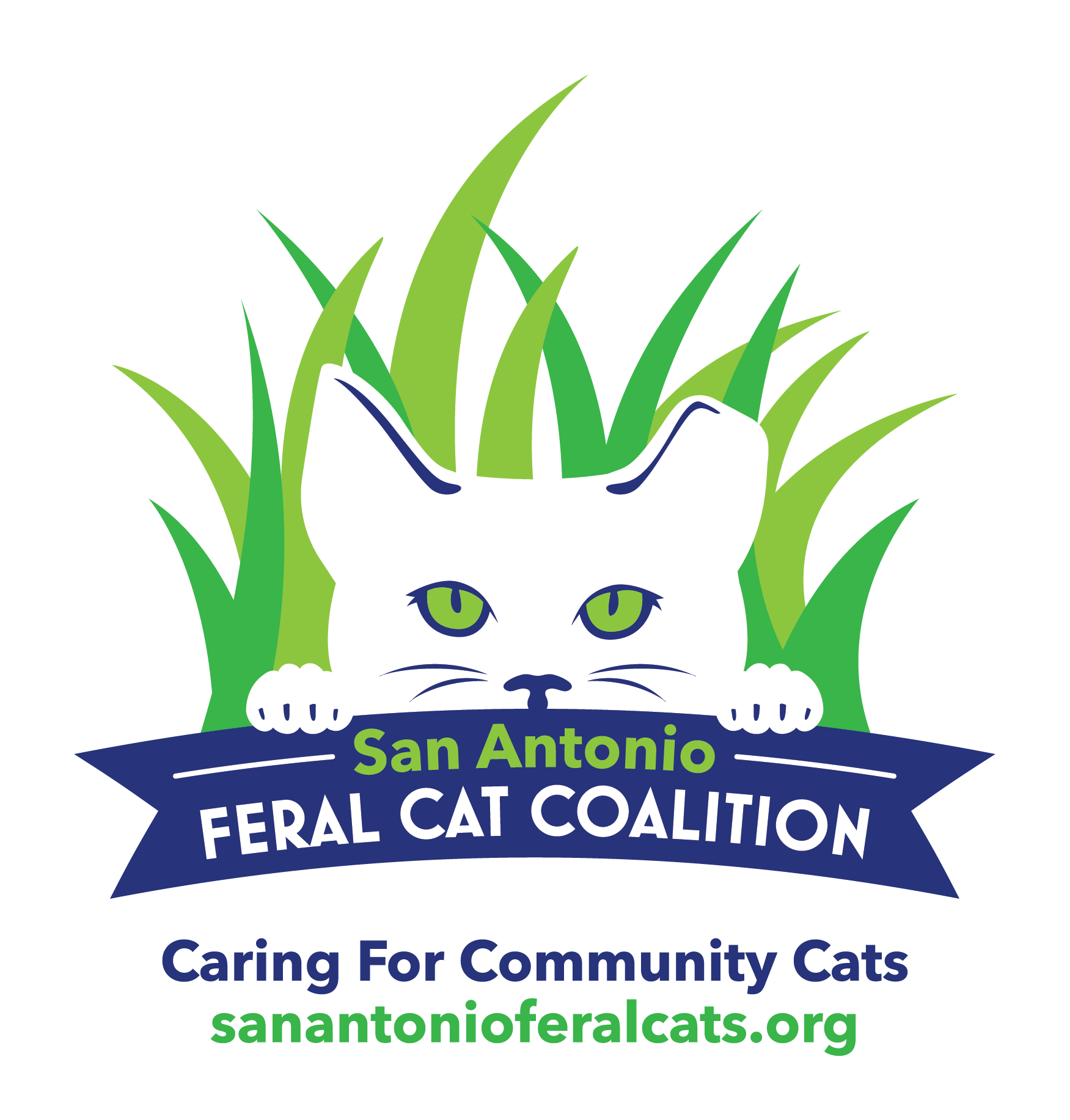flyers, forms & information
Please click on the tabs below to see more information on each topic. Thank you!
Flyers
- SAFCC Feral Shelter Program
- SAFCC Informational Brochure
- SAFCC Apartment Brochure
- SAFCC Neighborhood Flyer
- SAFCC Neighborhood Flyer (información en español)
- SAFCC HOA Brochure
- SAFCC TNR Fact Sheet for Apartments
- Animal Care Services supports Trap-Neuter-Return (TNR) for community cats
- Is declawing harmful to cats?
- Facts & Fallacies About Free-roaming Cats
- FIV+ Cat Facts
- The Cost of a “FREE” Cat/Kitten
- Relocation of Cats (A last resort!)
- Petco Love Lost
Forms
Information
There is a wealth of information on the Internet related to feral cats. We’re not going to reproduce all of them, but here is a list of some of the better ones:
- New feeding laws effective January 1,2021
- Taking care of colonies
-
- Flea information
- Proper feeding guidelines
-
Advocacy for Cats
Protecting & improving cats’ lives is very important. You can be a champion for the humane treatment of feral cats. Read more information on advocating for cats below:
Kitten 101 Class
Cat Rescue: Call To Care
Frequently Asked Questions
Who We Are
San Antonio Feral Cat Coalition (SAFCC) is a public 501(c)(3) nonprofit organization comprised entirely of volunteers. Most of us work at full-time jobs and then work on SAFCC issues after we get home from work and on weekends. We do not have paid staff nor do we have anyone working on feral or stray cat issues full time.
What do you do?
We are organized primarily to provide information resources to the public and to other animal welfare organizations. We educate people about issues surrounding feral and free-roaming cats in their environments, tell people where to take cats to be spayed or neutered, how to take care of the cats during post-surgery recovery, and how to take care of the cats long-term after they’ve been spayed/neutered.
We have a supply of humane animal traps that we rent to people that need to trap cats to be spayed/neutered and some large cages (dog training crates) that we also rent to people for holding the cats in after they’ve been spayed/neutered and before the cats are returned to their environment (feral cats) or being placed for adoption (tame/adoptable cats).
We provide information (pamphlets, fact sheets) to anyone who wants to know more about feral or stray cats or who wants information on the Trap-Neuter-Return (TNR) process. We try to support feral cat colony caretakers to the extent that our resources will allow (food, spay/neuter appointments, etc.). Finally, we work with local government officials to promote TNR in San Antonio instead of the usual way of doing business, which, up to this point, has been trap and kill or doing nothing about the cat overpopulation problem. More information about our organization is located at About.
.
What is a feral cat?
It is either a cat who has lived his whole life with little no human
contact and is not socialized or a stray cat who was lost or abandoned and has lived away from human contact long enough to revert to a wild state. Feral cats avoid human contact and cannot be touched by strangers. (Source: Alley Cat Allies)
Are stray cats and feral cats the same?
No. Adult feral cats usually cannot be tamed and are not suited to living indoors with people. However, feral kittens up to about 8 weeks often can be tamed and adopted. (Source: Alley Cat Allies)
How can you tell the difference between a stray and a feral cat?
Observe the cat’s appearance and behavior. A stray cat is more likely to approach a human, but not close enough to be touched. It is also more likely to be vocal and eat food right after is it offered. A feral cat is silent, will not approach humans and will only approach food after a human has moved away from it. Strays are more likely to look disheveled, compared to feral cats which have adapted to the conditions and will be well-groomed. (Source: Alley Cat Allies)
I have several stray/feral cats that showed up in my yard? Can you take them?
No. SAFCC does not take cats from people. We are not a rescue organization, nor do we have adequate facilities to shelter the cats from all of the people who call asking for us to take their cats away.
Where can I find low-cost spay/neuter services?
See our web page at Resources.
I have a bunch of cats that I need to get rid of, can you come pick them up?
As already mentioned, our organization simply does not have the resources to remove feral or stray cats from your yard, apartment complex, or place of business. We encourage you to feed the cats so that they won’t starve. More importantly, we encourage you to help us resolve the problem by taking the next step and trapping the cats and getting them spayed or neutered. This will stop the breeding cycle. Tame cats can be placed for adoption.
How do I trap a cat and how can I find out more about Trap-Neuter-Return?
You should really try to get to one of our online workshops. At these workshops, we show you how to trap cats using humane animal traps, cover lots of resources for spaying/neutering, and make every effort to answer any questions you may have about dealing with stray and feral cats. The online workshops are free.
So if I have some cats or kittens that are adoptable, what do I do with them?
Try the same things we do: Call the Humane Society (210-226-7461) every day at 8:30 am and see if you can get them to take the cats from you; Call the Animal Defense League (210-655-1481) and get on their list to take the cats in; Call SCAT (Stray Cat Adoptions of Texas, 210-363-8010) and see if they will take them in. There are also several other shelters in the area who might be able to take them in, as well as different agencies that place cats for adoptions at various PetsMarts around the city. You might also try and enlist the aid of friends or other family members to foster the cats on a short-term basis until some of the above places have room to take them.
I have a mom cat and several kittens. What should I do?
The first thing you need to do is consider the welfare of the kittens. If they are very young (say, less than about 5-6 weeks) then they need to stay with their mother until they are weaned and can eat solid food on their own. [1] Once the kittens are eating solid foods, they should be removed from the environment and fostered by someone until they are old enough to be placed for adoption. From the time the kittens are taken away from their mother and until they are ready to be adopted, this is the time that they should be tamed, or socialized, to learn how to interact with people. Also, after kittens are removed from their mother, the mom cat should be taken into a veterinary clinic and spayed. The spayed mom can then be returned to the place she was living. She should be helped along with regular feeding by yourself or another volunteer.
How old is this kitten?
“Kittens are adorable at any age, but did you know that figuring out how old a kitten is can help determine what sort of care they need? It can be tricky to tell, but our at-a-glance kitten progression guide, featuring Darling the kitten and his siblings, is here to help you out.” Click this link to read more and see photos that show the kitten’s age.
Found kittens?
Not sure what to do if you’ve found kittens in your community? Please click this link to read more and see photos and charts that will help you.
What can I do to help?
Here are some suggested things you can do to help:
- Provide responsible, humane care for your own cats
- Let the City Council and local businesses know that you support the Trap-Neuter-Return program in your community
- Encourage ongoing efforts to humanely address pet overpopulation in the community
- Spay or neuter your own pets and prevent them from roaming
- If feeding stray or feral cats, be sure that they are all spayed or neutered
- Young kittens and social adult strays should be taken in, sterilized and adopted into permanent homes. Contact the Humane Society or other shelters.
- Help local project coordinators identify feral cat colonies; Contact our Help Line at 210-877-9067 and ask if there is anyone taking care of feral cat colonies that you find
- Volunteer to help with trapping or to help monitor and care for the cats once they are returned to their colonies
- Volunteer to help monitor and feed colonies
Notes:
[1] Kittens will continue to nurse from their mother even after they start eating solid foods.
Bottle feeding kittens
“When a kitten is without a mother, it’s up to us to lend a hand. Bottle feeding is an essential skill for any kitten rescuer, and Kitten Lady makes it easy to learn with this step-by-step tutorial. Anyone can learn to bottle feed, but there are some tips you’ll want to have in order to do so safely.”
Read more at the Kitten Lady Website








